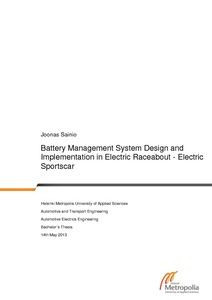Forecasting of Bidding Strategies for Participation in Finnish Electricity Balancing Market : A Case Study of Electric Vehicle Charging As Power Reserve
Karki, Bhuwan (2024)
Karki, Bhuwan
2024
All rights reserved. This publication is copyrighted. You may download, display and print it for Your own personal use. Commercial use is prohibited.
Julkaisun pysyvä osoite on
https://urn.fi/URN:NBN:fi:amk-2024053119069
https://urn.fi/URN:NBN:fi:amk-2024053119069
Tiivistelmä
Electric Vehicle (EV) sales and popularity are increasing because it is a sustainable and environmentally friendly way of transportation. EVs reduce fossil fuel dependency and reduce (carbon dioxide) CO2 emissions. Due to its random and volatile nature, increasing demand for charging burdens the electric grid. EVs can be considered energy storage with available energy and capacity constraints that can provide flexibility to the power system by balancing products when aggregated. Electric vehicle charging stations can participate in frequency reserves markets by curtailing the charging current during under-frequency. Frequency Containment Reserve in Disturbance (FCR-D) is a frequency- based control logic that aims to adjust the frequency of the electric system by activating reserves. The station operator’s readiness to respond to under-frequency situations determines their compensation. This compensation incentivizes the operator to stay alert and take immediate action if necessary, ensuring an uninterrupted power supply. Recognizing the crucial role that the station operator plays in maintaining a reliable power grid, their compensation reflects the value of their expertise and dedication. Forecasts of charging patterns are essential to reliably providing this ancillary service. This paper aims to build a generalized model for forecasting EV charging demand and the FCR-D upward price. Forecasting demand capacity and FCR-D upward price is typically done using traditional and deep learning approaches based on time series analysis. We use two distinct datasets to forecast demand and FCR-D upward price using both univariate and multivariate methods. The forecasting horizon is typically one month. Different forecasting algorithms include MSTL, ETS, NHiTS, TiDE, and Dlinear. MSE, MAE, RMSE, and SMAPE were used to compare model performance. According to the result, the NHITS outperforms other models in terms of long-term forecasting for univariate with the EV charging demand data and Tide for multivariate. Similarly, for forecasting the FCR-D upward Price, NHiTS for univariate and TiDE for multivariate outperform the other models.
Kokoelmat
Samankaltainen aineisto
Näytetään aineisto, joilla on samankaltaisia nimekkeitä, tekijöitä tai asiasanoja.
-
Solar Electricity Utilization in Finland : An Hourly Comparison of Photovoltaic System Output Data and Simulated Building Electricity Load Profiles
Meyer, Joachim (Metropolia Ammattikorkeakoulu, 2015)The goal of this thesis was to emphasize the importance of comparing photovoltaic (PV) elec-tricity production and building electricity load profiles on an hourly basis in order to assess the feasibility of grid-connected ... -
Study on Consumer Demand on Electric Cars: The challenges related to battery electric vehicle adoption in Europe and expectations set by the customer base of Škoda Finland
Mattila, Jari (2019)Sähköauto on aiheena yksi keskeisimpiä ja ajankohtaisimpia tämän päivän autoteollisuudessa ja mediassa. Aihe herättää kiinnostusta myös laajalti alan ulkopuolella, ja lähestulkoon kaikki eurooppalaiset kuluttajat ovat ... -
Battery Management System Design and Implementation in Electric Raceabout - Electric Sportscar
Sainio, Joonas (Metropolia Ammattikorkeakoulu, 2013)The purpose of this Bachelor´s study was to design and implement a new user-configurable battery management system into Electric Raceabout – electric sports car. This new improved system design would replace the old battery ...



